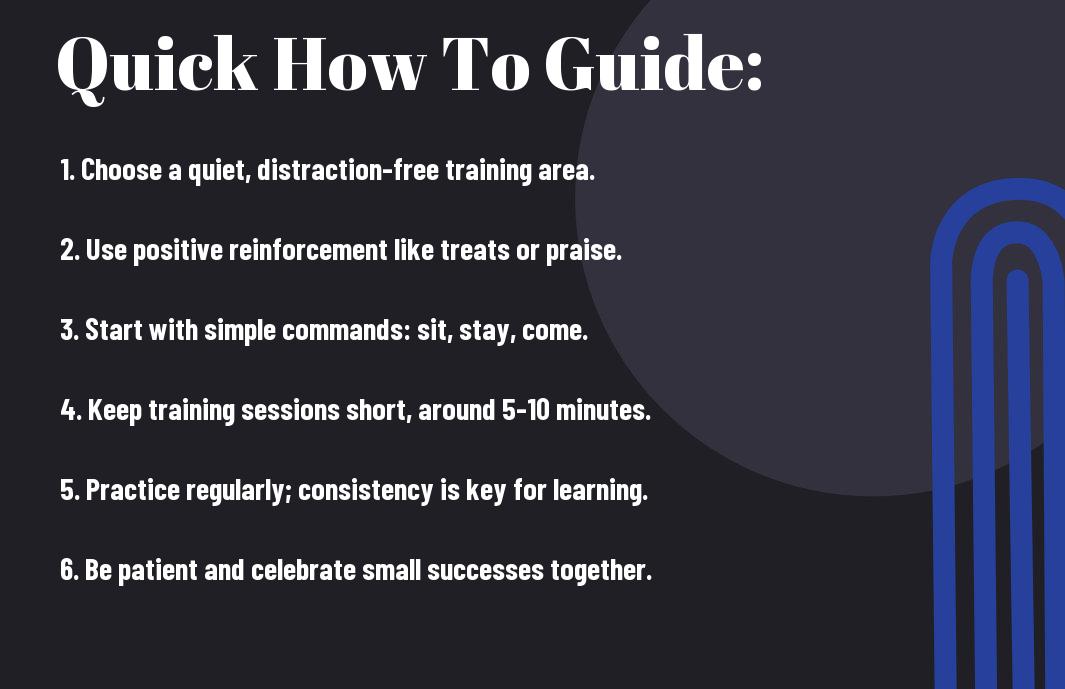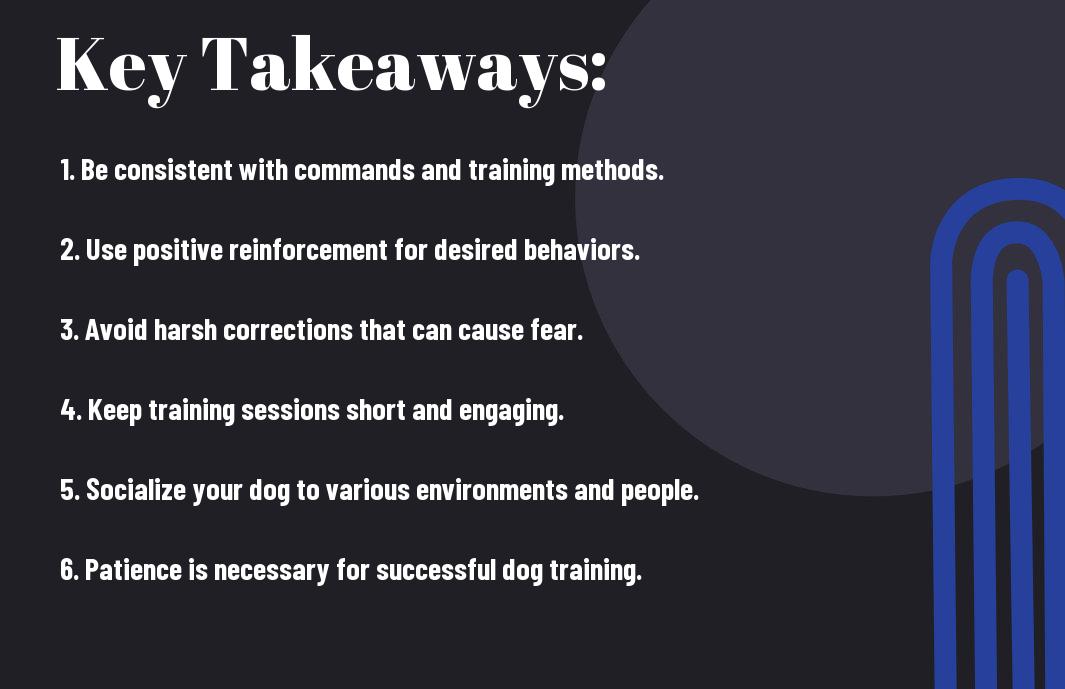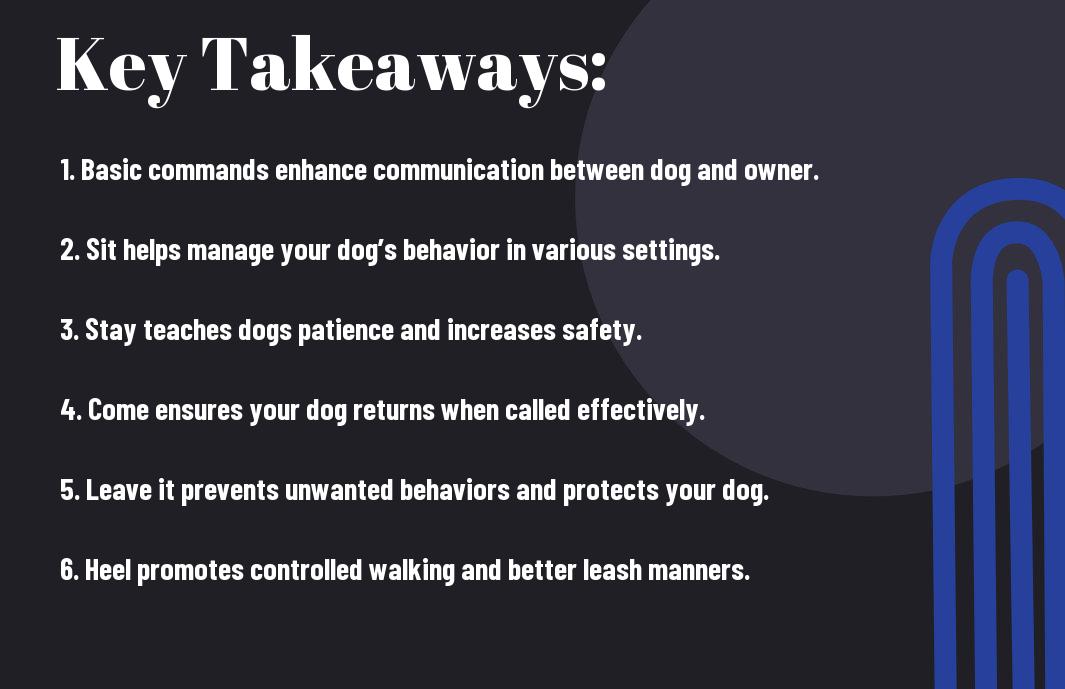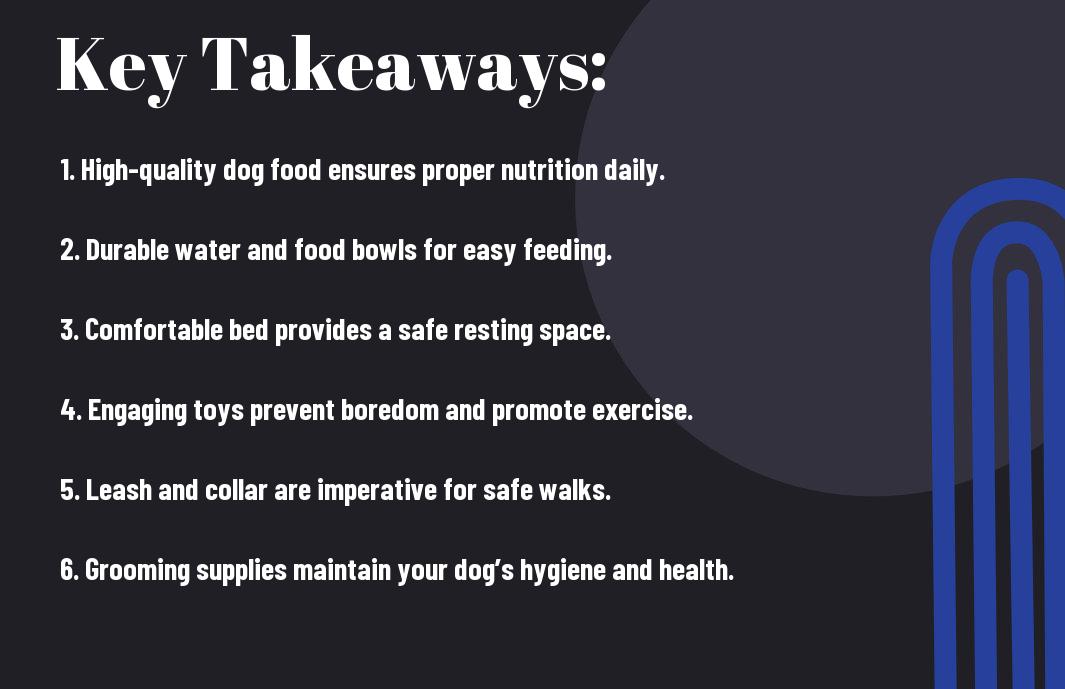Commands can transform your dog’s behavior and strengthen your bond. Teaching basic commands like “sit,” “stay,” and “come” is vital for their safety and your peace of mind. By using positive reinforcement techniques, you encourage your dog to respond eagerly and build a foundation for more advanced training. This guide will provide you with effective tips and tricks to ensure you and your furry friend initiate on a successful training journey together.

Understanding Your Dog
The journey of training your dog begins with a solid understanding of their unique personality and behaviors. By recognizing how your dog perceives the world, you can tailor your training approach to be more effective. Dogs, like humans, have distinct characteristics that influence how they respond to commands and situations. Taking the time to observe your dog’s reactions, energy levels, and stress signals can provide valuable insights into their learning process. Understanding these nuances will allow you to create a training environment that aligns with your dog’s needs.
Factors Affecting Training Success
There are several factors that can significantly impact your success in training your dog. One primary factor is the dog’s age; puppies tend to learn faster because they are more receptive to new experiences. Additionally, the breed of your dog can influence their learning capability, as some breeds are known for their intelligence and eagerness to please. Another aspect is the consistency of training; using uniform commands and signals will help your dog understand what you expect of them. Lastly, your own patience and commitment play a vital role in your training process.
- Age of your dog
- Breed characteristics
- Consistency in commands
- Patience in training
Knowing these factors will help you tailor your training techniques and improve communication with your dog.
Dog Learning Styles
Learning styles in dogs can vary significantly, and understanding these styles is vital for effective training. Just as people learn differently, dogs have their unique ways of absorbing information. For example, some dogs may respond best to visual cues, while others may excel with auditory commands or hands-on training. It’s important to observe your dog’s reactions to different training methods, as this will help you determine which style works best for them, ensuring a successful learning experience.
Styles of learning include visual, auditory, and kinesthetic methods. Each dog may gravitate toward one or combine elements of different styles. By recognizing your dog’s dominant learning style, you can create a more engaging and effective training routine that utilizes their strengths. Understanding these styles can also enhance your bond with your pet, since you’ll be speaking their language, making training a positive experience for both of you.

Essential Training Tools
Some tools can greatly enhance your dog training experience. When teaching your dog basic commands, having the right equipment can make a significant difference in how effectively you communicate with your new companion. This section will explore necessary training tools that will help facilitate your training sessions and ensure your dog learns in a positive and effective manner.
Clickers and Treats
If you want to encourage good behavior and reinforce learning, clickers and treats are valuable tools in your training arsenal. A clicker is a small device that makes a distinct sound when you press it, signaling to your dog that they did something right. Pairing this sound with a treat creates a clear association, allowing your dog to understand which behavior you are rewarding. When choosing treats, opt for small, highly desirable options that your dog will be enthusiastic about, thus making the training process much more enjoyable for them.
If you incorporate clicker training into your sessions, be sure to click the moment your dog performs the desired action. This timing allows for a direct connection between the sound and the behavior, which can significantly speed up the learning process. As you progress through the commands, gradually reduce the frequency of treats, giving them sporadically to maintain your dog’s motivation and engagement.
Leashes and Collars
Essential to any dog training routine, leashes and collars allow you to maintain control and safety during training sessions. Selecting the right collar is important; it should be comfortable for your dog while also being effective in guiding their behavior. For training purposes, consider using a flat collar or a harness, as they provide control without causing unnecessary pressure on your dog’s neck. Avoid using choke chains or prong collars, as they can cause harm and anxiety, leading to additional behavior problems.
Collars not only play a role in safety but also help reinforce training commands. A properly fitted collar enables you to lead your dog while teaching them positions like “heel” or “stay.” It’s necessary to make sure that your dog is accustomed to wearing their collar without stress or discomfort, as this will help create a more positive training environment. When used alongside a leash, these tools can make your training sessions more structured and successful.

The Basic Commands
After you have established a positive atmosphere for training, it’s time to investigate teaching your dog the basic commands. These commands are necessary for communication and can enhance the bond between you and your pet. Basic commands like “Sit,” “Stay,” “Come,” “Down,” and “Heel” serve as building blocks for your dog’s behavior and obedience.
Teaching Sit
If you want to teach your dog to “Sit,” start by holding a treat close to their nose. Slowly move your hand upward, allowing your dog’s head to follow the treat. As their head goes up, their bottom will naturally lower. When they are in the sitting position, say “Sit” and give them the treat. It’s important to offer lots of praise and encouragement to make the experience enjoyable for them.
Once your dog starts to sit on command, practice consistently in different locations and with varying levels of distractions. The goal is to strengthen their understanding that “Sit” means to lower their back end, regardless of the environment. Keep the training sessions short and fun, ensuring your dog remains engaged and motivated.
Teaching Stay
Any time you want to teach “Stay,” it is important to ensure your dog understands the concept of remaining in place. Start with your dog in a sitting position, then hold your palm out in front of you and say “Stay.” Take a step back while maintaining eye contact. If your dog remains seated, reward them with a treat.
Gradually increase the distance and duration as they become more comfortable with the command. It’s necessary to stay calm and avoid rushing the process, as this could lead to confusion. Offering consistent praise for their progress can significantly boost their confidence and adherence to the command.
Teaching “Stay” can be particularly beneficial in situations where you need your dog to wait, such as at the vet’s office or when hosting guests. The key is to be patient, as each dog learns at their own pace. Regular practice will help solidify their understanding.
Teaching Come
For your dog to understand the command “Come,” start by using a leash in a quiet, enclosed space. Call your dog’s name followed by “Come,” while gently pulling on the leash if necessary. When your dog approaches you, reward them immediately with a treat and lots of praise. By making the experience positive, you encourage them to come to you in the future.
It’s also helpful to practice the “Come” command during playtime, as this adds an element of fun. Make sure to vary your tone of voice to express excitement, and avoid calling them for negative experiences, like a bath. This will help prevent any negative associations with the command.
For instance, once your dog learns to come consistently on a leash, practice in an area with minimal distractions to encourage success before trying it in a more stimulating environment. This gradual approach helps build their confidence in obeying the command.
Teaching Down
Teaching your dog to “Down” involves a few simple steps. Begin with your dog in a sitting position. Hold a treat close to their nose, then slowly lower the treat down to the ground, encouraging them to follow it. You may need to use a gentle downward motion with your hands as you say “Down.” Once they are lying down, immediately reward them with the treat and praise.
Consistency is key, so practice regularly in different environments, gradually increasing the level of distraction. Reinforcing this command can help calm your dog in various situations, establishing a sense of security and obedience.
To make the process smoother, aim to practice “Down” when your dog is calm and focused. A relaxed environment can facilitate quicker understanding, making your training sessions more effective.
Teaching Heel
Teaching “Heel” involves getting your dog to walk beside you without pulling on the leash. Begin in a quiet area with your dog on a leash. Hold a treat at your side and use the command “Heel” to encourage them to walk with you. If they pull ahead, gently tug the leash back to bring them alongside you, rewarding them when they are in position.
Gradually introduce the command in busier areas, rewarding your dog for maintaining position while also teaching them to ignore distractions. This skill not only keeps your walks enjoyable but can also ensure your dog’s safety in high-traffic situations.
Come to understand that establishing a strong connection with your dog through the “Heel” command sets a foundation for future coordination. Regular practice and positive reinforcement will create a strong bond and improve your dog’s responsiveness.
Effective Training Techniques
Not every training technique works for every dog, and finding the right method is key to successful command teaching. The most effective training techniques are often those that create a clear, positive environment where your dog can learn and thrive. By combining several approaches, you can tailor your training sessions to fit your dog’s unique personality and behavioral traits.
Positive Reinforcement
For effective training, positive reinforcement is important. This method involves rewarding your dog for performing the desired behavior or command, thereby encouraging them to repeat it in the future. Rewards can be treats, praise, or playtime, but it’s important to choose something your dog finds genuinely motivating. This approach not only fosters a positive relationship between you and your dog but also enhances their eagerness to learn.
Additionally, the timing of your rewards is vital. You should immediately reward your dog after they perform the command correctly so they can easily associate the action with the positive outcome. By consistently using positive reinforcement, you can create a more effective and enjoyable learning environment for your dog.
Consistency in Commands
The key to instilling commands in your dog’s mind is to maintain consistency. Dogs learn best when they receive clear and unambiguous signals regarding what is expected of them. This means that you should use the same word or phrase for each command and avoid using variations. If ‘sit’ is the command you choose, always use ‘sit’—not ‘sit down’ or ‘get down’—to eliminate any confusion.
Moreover, it’s important for all family members involved in training to use the same commands and signals. This will prevent mixed messages that could confuse your dog and hinder their progress. Ensuring that everyone is on the same page creates a stable environment, which is vital for effective training.
Reinforcement of commands can be achieved by practicing them in various settings. This helps your dog generalize the command, understanding that it applies not just at home but in different environments as well. Regular practice will not only strengthen their understanding but also solidify your role as a reliable leader in their learning process.
Patience and Timing
Effective training requires a great deal of patience and timing. Every dog learns at their own pace, and it’s important to remain calm and patient during the training process. If your dog struggles to grasp a command, take a step back and reassess your method. Remain encouraging and avoid expressing frustration, as this can negatively impact your dog’s willingness to learn.
It’s also important to pay attention to the timing of your commands and corrections. Deliver commands clearly and avoid repeating them unless necessary, as this can dilute their effectiveness. If your dog makes a mistake, correct them gently but promptly, ensuring that they understand what is expected. This effective timing reinforces the learning process, helping your dog to make the connection between the command and their behavior.
For instance, if your dog is learning to ‘stay’, you should give the command once clearly and allow them a moment to process it. If they move before you’re ready, gently guide them back to the correct position and repeat the command, without overwhelming them. This respectful approach ensures your dog can focus on what you’re teaching, facilitating a smoother learning journey together.
Common Training Challenges
To successfully train your dog, it is imperative to acknowledge and address common training challenges that may arise. These can range from distractions and resistance to behavioral issues. By understanding these challenges and applying effective strategies, you can create a more productive training environment and strengthen your bond with your dog.
Addressing Distractions
An important factor in your dog’s training is their ability to focus amidst various distractions. Whether it’s the sound of other dogs barking, moving cars, or even other people, distractions can greatly hinder your dog’s ability to learn and execute basic commands. To address this, it’s advisable to start training in a quiet, controlled environment before gradually introducing distractions as your dog becomes more confident and responsive. Using high-value treats can also help maintain their attention during these sessions.
As your dog masters the commands in a distraction-free setting, you can begin to incorporate mild distractions—like having another pet nearby or practicing in a park. Ensure that you reward your dog generously for maintaining focus in these situations. This can lead to improved responses to commands, even when more significant distractions are present.
Dealing with Resistance
Little setbacks are common when your dog is resistant to following commands. Resistance may manifest in various forms, such as ignoring you, showing signs of anxiety, or even becoming frustrated. Understanding why your dog might be resistant is imperative. It could be due to a lack of motivation, confusion about the command, or simply being overstimulated. In these cases, reassessing your training methods and ensuring that sessions are short and engaging can make a significant difference.
This resistance often stems from a misalignment between the command and your dog’s understanding of what you want. You might find that varying your approach—such as using different rewards or introducing play as a motivating factor—can build your dog’s enthusiasm for training. Additionally, patience is key; celebrating small wins helps create a positive reinforcement loop, leading to better compliance over time.
Managing Behavioral Issues
You may encounter behavioral issues during training that can hinder the learning process. Common issues include barking, jumping, or chewing. These behaviors often reflect your dog’s need for attention or exercise, so it’s vital to address the root cause rather than just the symptoms. Incorporating structured routines that include plenty of exercise and mental stimulation can greatly minimize these behaviors, giving your dog an outlet for their energy and attention-seeking tendencies.
Dealing effectively with behavioral issues requires consistency and the use of redirects. Instead of punishment, focus on redirecting your dog towards appropriate behaviors, offering praise and rewards when they comply. By providing clear guidelines and a supportive approach, you can help your dog understand what is expected, leading to better overall behavior during training sessions.
Advanced Tips for Training
Keep in mind that training your dog goes beyond just teaching basic commands. Here are some advanced tips you can apply to enhance your pet’s training experience:
| Tip | Description |
|---|---|
| Use Positive Reinforcement | Reward your dog with treats or praise when they follow commands correctly. |
| Consistency is Key | Keep training sessions frequent and ensure everyone in your household uses the same commands. |
| Short Sessions | Keep training sessions to about 5-10 minutes to maintain your dog’s focus. |
| Patience is Essential | Allow your dog to learn at their own pace and avoid expressing frustration. |
Socialization with Other Animals
To ensure your dog is well-adjusted and comfortable around other animals, socialization is key. Taking your dog to dog parks or arranging playdates with other friendly pets can help your dog learn appropriate behavior. This exposure allows your dog to practice commands in a real-world scenario, making the training more effective.
It’s important to supervise these interactions to guarantee safety. If your dog shows signs of anxiety or aggression, it’s a good idea to remove them from the situation and try again later. Socializing your dog in controlled environments can greatly improve their confidence and adaptability.
Engaging with Different Environments
To help your dog become accustomed to a variety of environments, expose them to different settings regularly. This could include parks, busy streets, or even crowded areas. By varying the scenery, you help your dog practice commands in different contexts, enhancing their overall training experience.
Additionally, introducing your dog to various challenges, such as stairs, uneven ground, or loud noises, helps make them more resilient to potential distractions in their surroundings. Having a confident dog will not only make training easier but will also ensure that your dog is safe in unpredictable situations.
Socialization is about more than just meeting other dogs—it’s about ensuring that your dog feels comfortable in diverse environments. Gradually increasing the complexity of the settings can reinforce positive behaviors and compliance with your commands.
Gradual Increase of Difficulty
Socialization also extends to the concept of gradually increasing the difficulty of your dog’s training exercises. Start with simple commands and recognizable environments, then slowly introduce complexity with more distractions or difficult tasks. This approach builds your dog’s confidence and equips them with skills for various scenarios.
Maintain a structured training plan that can help track your dog’s progression. As your dog masters each command or behavior, elevate the difficulty level by incorporating more distractions or trying commands in more challenging situations.
For instance, if your dog can sit on command in your living room, try asking them to do it in a park with people around. By steadily increasing the difficulty, you ensure your dog remains engaged and responsive to your commands. This approach fosters both obedience and a sense of achievement for your dog.
Final Words
Taking this into account, teaching your dog basic commands is not only important for their obedience but also for building a stronger bond between you and your furry friend. By utilizing consistent training techniques and positive reinforcement, you create an environment where learning becomes enjoyable for both you and your dog. Engage in training sessions that are brief yet frequent, allowing your dog to absorb and understand the commands better, while ensuring that they look forward to the process.
As you begin on this journey of training, you will unveil your dog’s potential while instilling good manners and a sense of discipline. Stay patient and attentive, as every dog learns at its own pace. Your commitment to training will yield not only a well-disciplined pet but also a companion who feels secure and valued. Enjoy the moments of progress and celebrate small victories along the way, as each step brings you and your dog closer to achieving a harmonious relationship.
Q: What is the best way to start teaching my dog basic commands?
A: The best way to begin teaching your dog basic commands is to create a calm and distraction-free environment. Start with one command at a time, such as “sit” or “stay.” Use positive reinforcement techniques, like treats or praise, to encourage your dog when they successfully perform the command. Consistency is key; practice regularly and always use the same command word and gesture. This will help your dog understand what you expect from them.
Q: How long should I train my dog each day?
A: Training sessions should be short and engaging to keep your dog interested and focused. Aim for about 5 to 10 minutes of training per session, especially for younger or more easily distracted dogs. If your dog is enjoying the process and staying engaged, you can extend the session slightly, but it’s important to avoid overwhelming them. Frequent, short sessions throughout the day are more effective than longer, infrequent ones.
Q: What should I do if my dog is not responding to commands?
A: If your dog is not responding to commands, it could be due to a few reasons. First, ensure that you are using clear and consistent cues, both verbal and physical. Secondly, evaluate the training environment to minimize distractions. If your dog still struggles, consider changing your approach by using higher-value treats or incorporating play into the training. Sometimes, taking a break and returning to the basics can also help re-engage their interest and focus.










